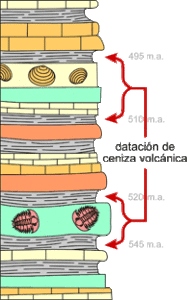Los geólogos utilizan la datación radiométrica para estimar cuánto tiempo hace que se formaron las rocas y para inferir la edad de los fósiles que esas rocas contienen.
Los elementos radiactivos se desintegran
El universo está lleno de elementos radiactivos de origen natural. Los átomos radiactivos son inestables por naturaleza; a lo largo del tiempo, los «átomos padre» se desintegran en productos estables.
Cuando la roca fundida se enfría forma las llamadas rocas ígneas y los átomos radiactivos quedan atrapados en su interior. Después, estos átomos radiactivos se van desintegrando a una velocidad predecible. Midiendo la cantidad de átomos inestables que quedan en una roca y comparándola con la cantidad de átomos estables que hay en la roca, los científicos pueden estimar el tiempo que ha transcurrido desde que se formó esa roca.
 Los fósiles entre las rocas
Los fósiles entre las rocas
En general, los fósiles se encuentran en las rocas sedimentarias, no en las rocas ígneas. Las rocas sedimentarias pueden datarse utilizando el carbono radiactivo pero, debido a que el carbono se desintegra relativamente rápido, este método sólo funciona en rocas de menos de 50 mil años.
Por lo tanto, para datar la mayoría de los fósiles más antiguos, los científicos buscan yacimientos de roca ígnea o ceniza volcánica por encima y por debajo del fósil. Datan la roca ígnea utilizando elementos que se desintegran lentamente, como el uranio y el potasio. Mediante la datación de estas capas que lo rodean se puede averiguar cuál es la edad más moderna y la más antigua que podría tener ese fossil. Con esta metodologia, pueden delimitar la edad de la capa sedimentaria en la que se encuentran los fósiles.
Teach your students about absolute dating: Determining age of rocks and fossils, a classroom activity for grades 9-12.
Find additional lessons, activities, videos, and articles that focus on relative and absolute dating.
Original translation by the Spanish Society of Evolutionary Biology; translation editing by Maya deVries
